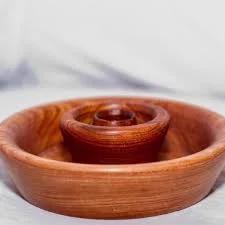A Beginner's Guide to Lathe Work
The rhythmic hum of the lathe, the fragrant scent of freshly turned wood, and the satisfaction of transforming a simple block into a work of art – these are the hallmarks of woodturning. This captivating art form allows you to breathe life into wood, creating everything from delicate spindles to robust bowls. Whether you're a woodworking enthusiast or simply curious about this traditional craft, this beginner's guide to lathe work equips you with the essential knowledge to embark on your woodturning journey.
Imagine a spinning lathe, holding a block of wood that transforms with each precise cut. As you guide the tools, the wood yields, revealing its hidden beauty and potential. Woodturning offers a unique blend of creativity, technical skill, and meditative focus, making it a rewarding and endlessly fascinating pursuit.
H2: The Heart of the Craft: Unveiling the Wood Lathe
The wood lathe is the cornerstone of woodturning. Here's a breakdown of its key components:
- Headstock: This houses the motor that drives the lathe's rotation. Speed control allows for adjustments based on the project and wood type.
- Tailstock: This movable component provides support for the opposite end of the workpiece, ensuring stability during turning.
- Bed: This sturdy base supports the headstock, tailstock, and tool rest, creating a stable platform for your work.
- Spindle: This rotating shaft connects to the headstock and extends towards the tailstock, holding the wood securely.
- Tool Rest: This adjustable rest supports your woodturning tools, allowing for precise control and application of cutting pressure.
H2: Essential Tools for the Turning Journey
Beyond the lathe, several tools are essential for your woodturning endeavors:
- Roughing Gouge: This robust tool removes large chunks of wood, shaping the initial form of your project.
- Spindle Gouge: Used for shaping and smoothing curved surfaces on your turning.
- Parting Tool: This tool creates clean cuts and defines specific diameters on your workpiece.
- Chisels: A set of chisels with various sizes and profiles allows for detailed shaping and finishing touches.
- Calipers: These measure the thickness and diameter of your workpiece, ensuring precise dimensions.
- Sandpaper: Sandpaper in various grits is used for smoothing the surface of your turned object to a polished finish.
- Safety Gear: Always wear safety glasses, a dust mask, and gloves to protect yourself from flying debris and cuts.
H2: The Turning Process: A Step-by-Step Guide
With your lathe and tools at hand, it's time to begin your woodturning adventure! Here's a basic breakdown of the turning process:
- Mount the Wood: Secure the wood block between the centers of the headstock and tailstock using a spur drive or a chuck (depending on the project).
- Roughing Out: Using the roughing gouge, remove excess wood, gradually shaping the overall form of your project.
- Refining the Shape: Employ the spindle gouge and chisels to refine the curves and details of your turning.
- Parting and Detailing: Use the parting tool to create clean cuts and define specific diameters. Detailing chisels help add final touches.
- Sanding: Smooth the surface of your turned object with progressively finer grits of sandpaper, achieving a polished finish.
H2: Safety First: Essential Practices for Woodturning
Woodturning involves rotating tools and sharp objects, so safety is paramount. Here are some key practices to remember:
- Always wear safety glasses, a dust mask, and gloves.
- Ensure your lathe is properly assembled and securely bolted to a sturdy surface.
- Sharpen your tools regularly for optimal control and to prevent accidents.
- Never reach over a spinning workpiece.
- Use the correct tool for the job and avoid forcing cuts.
- Start slow and increase speed gradually as you gain confidence.
- Be aware of your surroundings and keep loose clothing away from the lathe.
H2: Consultation: Launching Your Woodturning Journey
Feeling the urge to explore the magic of woodturning? Here are some resources to guide you on your path:
- Woodturning Classes and Workshops: Enroll in local classes or workshops to learn from experienced turners and gain hands-on experience.
- Online Tutorials and Videos: Numerous websites and YouTube channels offer a wealth of free and paid woodturning tutorials, covering various techniques and projects.
- Woodturning Books and Magazines: Invest in woodturning books and magazines for in-depth project ideas, detailed techniques, and safety tips.
- Join a Woodturning Club: Connect with other woodturners through local clubs or online forums. Share knowledge, learn from experienced turners, and participate in group projects for additional inspiration and motivation.
- Start Simple, Dream Big: Begin with beginner-friendly projects like simple spindles or small bowls. As you progress, challenge yourself with more intricate designs and explore different woodturning styles.
- Embrace the Learning Process: Woodturning is a lifelong journey of exploration and refinement. Enjoy the learning process, celebrate your achievements, and learn from your mistakes.
Beyond the technical aspects, woodturning offers a unique form of creative expression. As you turn the wood, a sense of calm and focus sets in. The rhythmic hum of the lathe becomes a familiar soundtrack to your creative journey. With each project, you not only create a beautiful object but also develop a deeper appreciation for the craft and the natural beauty of wood.
So, are you ready to embark on this captivating adventure? Gather your tools, find a space for your lathe, and unleash your inner woodturning artist. With dedication, practice, and the knowledge from this guide, you'll be well on your way to transforming simple blocks of wood into stunning creations!


